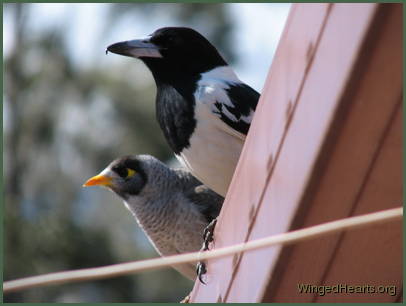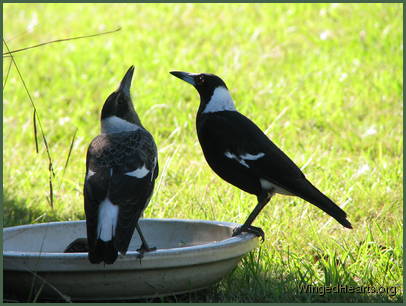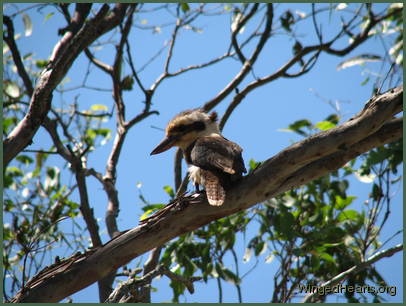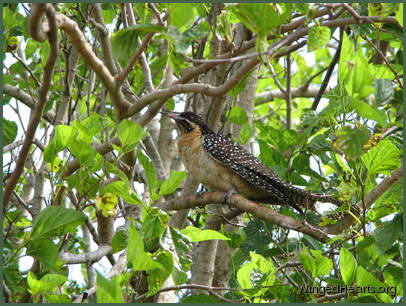Submitted by Gitie on 23 June, 2010 - 00:15
 Now the birds are getting used to you taking an interest in them. They are beginning to create their own patterns of understanding your words and behaviour, based on the sound and tones of your words and also your actions and movements.
Now the birds are getting used to you taking an interest in them. They are beginning to create their own patterns of understanding your words and behaviour, based on the sound and tones of your words and also your actions and movements.
In part 1 yesterday we covered - 1. Talking to the birds and 2. Watching Their Response.
Every species and every bird in every species will take their own time to respond to you. Some of the bolder birds will start coming forward giving you the opportunity to observe them at close range.
At this point there are a few different things you can start doing.

Submitted by Gitie on 20 June, 2010 - 00:14
The first step in making friends with the wild birds - is to create the opportunities to see them often.
 Not all of us have garden or are lucky enough to live at the edge of a rainforest or a green belt. Fortunately, birds are all around us whether we live in the city in a multi-storied apartment block or we live in the suburbs or countryside surrounded by nice lawns, shrubs and trees. The first thing you need to is to give the birds an incentive to come to your home, close enough to enable you to start forming a friendship.
Not all of us have garden or are lucky enough to live at the edge of a rainforest or a green belt. Fortunately, birds are all around us whether we live in the city in a multi-storied apartment block or we live in the suburbs or countryside surrounded by nice lawns, shrubs and trees. The first thing you need to is to give the birds an incentive to come to your home, close enough to enable you to start forming a friendship.

Submitted by Gitie on 19 June, 2010 - 00:15
 Wild Birds love communicating with each other, with birds from other species, with other animals and they absolutely love talking to humans. They may fly off in a flurry at the very start because they may not be sure of your intentions, or they may befeeling particularly shy or self-conscious. But once they realise that you are sincerely interested in them, they begin to respond and take an interest in you.
Wild Birds love communicating with each other, with birds from other species, with other animals and they absolutely love talking to humans. They may fly off in a flurry at the very start because they may not be sure of your intentions, or they may befeeling particularly shy or self-conscious. But once they realise that you are sincerely interested in them, they begin to respond and take an interest in you.
Once one bird gets the idea and starts

Submitted by Gitie on 29 April, 2010 - 21:35

Koels are shy and elusive birds. They tend to hide behind the thick foliage of fruit trees, hoping no one notices them while they eat their fill. The slightest hint that they are being watched causes them to fly off and find a more remote spot.

Pages

 Now the birds are getting used to you taking an interest in them. They are beginning to create their own patterns of understanding your words and behaviour, based on the sound and tones of your words and also your actions and movements.
Now the birds are getting used to you taking an interest in them. They are beginning to create their own patterns of understanding your words and behaviour, based on the sound and tones of your words and also your actions and movements. Not all of us have garden or are lucky enough to live at the edge of a rainforest or a green belt. Fortunately, birds are all around us whether we live in the city in a multi-storied apartment block or we live in the suburbs or countryside surrounded by nice lawns, shrubs and trees. The first thing you need to is to give the birds an incentive to come to your home, close enough to enable you to start forming a friendship.
Not all of us have garden or are lucky enough to live at the edge of a rainforest or a green belt. Fortunately, birds are all around us whether we live in the city in a multi-storied apartment block or we live in the suburbs or countryside surrounded by nice lawns, shrubs and trees. The first thing you need to is to give the birds an incentive to come to your home, close enough to enable you to start forming a friendship. Wild Birds love communicating with each other, with birds from other species, with other animals and they absolutely love talking to humans. They may fly off in a flurry at the very start because they may not be sure of your intentions, or they may befeeling particularly shy or self-conscious. But once they realise that you are sincerely interested in them, they begin to respond and take an interest in you.
Wild Birds love communicating with each other, with birds from other species, with other animals and they absolutely love talking to humans. They may fly off in a flurry at the very start because they may not be sure of your intentions, or they may befeeling particularly shy or self-conscious. But once they realise that you are sincerely interested in them, they begin to respond and take an interest in you.




